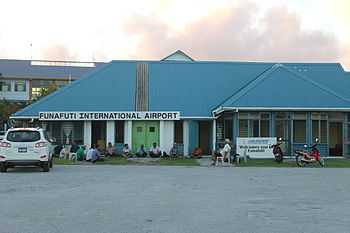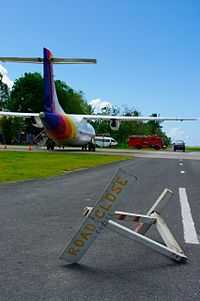Funafuti International Airport
| Funafuti International Airport | |||||||||||
|---|---|---|---|---|---|---|---|---|---|---|---|
 A Royal New Zealand Air Force Hercules aircraft landing at Funafuti International Airport | |||||||||||
| IATA: FUN – ICAO: NGFU | |||||||||||
| Summary | |||||||||||
| Airport type | Public | ||||||||||
| Location | Funafuti Atoll, Tuvalu | ||||||||||
| Elevation AMSL | 9 ft / 3 m | ||||||||||
| Coordinates | 08°31′30″S 179°11′47″E / 8.52500°S 179.19639°ECoordinates: 08°31′30″S 179°11′47″E / 8.52500°S 179.19639°E | ||||||||||
| Map | |||||||||||
 FUN Location in Tuvalu | |||||||||||
| Runways | |||||||||||
| |||||||||||
|
Source:[1] | |||||||||||
Funafuti International Airport (IATA: FUN, ICAO: NGFU) is an airport in Funafuti,[1][2][3] capital of the island nation of Tuvalu. Fiji Airways (trading as Fiji Link) operates three flights a week between Suva (originating from Nadi) and Funafuti with ATR 72-600 aircraft that have a capacity of 68 passengers and cargo.[4]
History

Funafuti Airport was built by United States Navy Seabee construction battalions in 1943 during World War II.[5]
The military airfield included an airstrip, control tower, facilities and radio station at Tepuka, connected by cable to the airfield. The base headquarters buildings were at the present-day Teagai Apelu's residence, and a bunker is there to this day.
The first offensive operation was launched on 20 April 1943 when 22 B-24 Liberator aircraft from 371 and 372 Bombardment Squadrons bombed Nauru. The next day the Japanese made a predawn raid on the strip at Funafuti that destroyed one B-24 and caused damage to five other planes. On 22 April, 12 B-24 aircraft bombed Tarawa.[6] The airfield became the headquarters of the United States Army Air Forces VII Bomber Command in November 1943, directing operations against Japanese forces on Tarawa and other bases in the Gilbert Islands. The USAAF stationed two B-24 Liberator heavy bomber groups, the 11th Wing and 30th Bombardment Groups on Funafuti in the implementation of Operation Galvanic, which lead to the Battle of Tarawa and the Battle of Makin in November 1943.[6]
By the middle of 1944, as the fighting moved further north toward Japan, the Americans began to withdraw. By the time the Pacific War ended in 1945, nearly all of them, with their equipment, departed.[7][8][9] After the war, the military airfield was developed into a commercial airport.
Facilities
The airport is at an elevation of 9 feet (3 m) above mean sea level. It has one runway which is 1,524 metres (5,000 ft) in length.[1] The absence of runway lighting, minimal VHF radio and air navigation equipment means that operations are restricted to daylight hours.[4]
The runway was originally constructed using coral aggregate and has a sub-base layer of 8 cm thick coral gravel, surfaced with a 1–2 cm asphalt chip seal. It was last resurfaced in 1992. The runway was originally rated at 50 tonnes landing capacity; it is now reduced to 20 tonnes landing capacity due to sub-surface water, deterioration of the sub-base and lack of surface maintenance.[4]
The deterioration of the runway's sub-base is a consequence of its low elevation and the hydrologic dynamics in the sub-surface of the atoll. There was extensive swamp reclamation during World War II to create the airfield. About half of Fongafale islet is reclaimed swamp that contains porous, highly permeable coral blocks that allow the tidal forcing of salt water through the sub-base of the runway.[10] This results in salt water pooling on the runway during spring tides.[11]
In November 2013 the World Bank approved US$6.06 million in finance for the existing Tuvalu Aviation Investment Project (TvAIP) for the purpose of improving operational safety and oversight of international air transport and associated infrastructure at Funafuti International Airport.[12]
Airlines and destinations

Up to 1999 Air Marshall Islands operated a Hawker Siddeley HS 748 with a passenger load of 55. In 2001 the government purchased a share of Air Fiji in 2001, which provided Tuvalu with greater control of its airline access; however, Air Fiji ceased operations in 2009.[4]
Air Pacific, the owner of Fiji Airlines (trading as Fiji Link) operates services 3 times a week (Tuesday, Thursday and Saturday) between Suva (originating from Nadi) and Funafuti with ATR 72-600, a 68-seat plane.
In February 2015 Samoa Air and Coral Sun Airways, of Kiribati announced their intention to provide regular flights to Funafuti in 8 seater aircraft.[13]
| Airlines | Destinations |
|---|---|
| Fiji Airways operated by Fiji Link | Suva |
References
- ↑ 1.0 1.1 1.2 Airport information for Funafuti Atoll, Tuvalu (NGFU / FUN) at Great Circle Mapper.
- ↑ Map of Funafuti Centre - Fogafale Motu. Tuvaluislands.com.
- ↑ Lal, Andrick. South Pacific Sea Level & Climate Monitoring Project - Funafuti atoll (PDF). SPC Applied Geoscience and Technology Division (SOPAC Division of SPC).
- ↑ 4.0 4.1 4.2 4.3 Andrew McIntyre, Brian Bell, and Solofa Uota (February 2012). ""Fakafoou – To Make New": Tuvalu Infrastructure Strategy and Investment Plan" (PDF). Government of Tuvalu. Retrieved 13 October 2013.
- ↑ "To the Central Pacific and Tarawa, August 1943 - Background to GALVANIC (Ch 16, p. 622)". Retrieved 2010-09-03.
- ↑ 6.0 6.1 James C. Olson, Wesley Frank Craven & James Lea Cate (Editors). "Chapter 9, The Gilberts and Marshalls". Army Air Forces in World War II: Vol. IV, The Pacific: Guadalcanal to Saipan - August 1942 to July 1944. Retrieved 12 October 2013.
- ↑
 This article incorporates public domain material from websites or documents of the Air Force Historical Research Agency.
This article incorporates public domain material from websites or documents of the Air Force Historical Research Agency. - ↑ Maurer, Maurer (1983). Air Force Combat Units Of World War II. Maxwell AFB, Alabama: Office of Air Force History. ISBN 0-89201-092-4.
- ↑ www.pacificwrecks.com
- ↑ Nakada S, Umezawa Y, Taniguchi M, Yamano H. (Jul–Aug 2012). "Groundwater dynamics of Fongafale Islet, Funafuti Atoll, Tuvalu". 50(4) Ground Water. pp. 639–44. Retrieved 5 May 2013.
- ↑ Nakada S., Yamano H., Umezawa Y., Fujita M., Watanabe M., Taniguchi M. (2010). "Evaluation of Aquifer Salinization in the Atoll Islands by Using Electrical Resistivity". 30 (5) Journal of the Remote Sensing Society of Japan. pp. 317–330. Retrieved 5 May 2013.
- ↑ "World Bank Approves Additional Funds for Tuvalu". World Bank. 1 November 2013. Retrieved 9 February 2015.
- ↑ "Tuvalu welcomes more flights". Radio New Zealand International. 9 February 2015. Retrieved 9 February 2015.
External links
| ||||||||||||||||||||||||||||||||||||||||||||||||||||||||||||||||||
.svg.png)